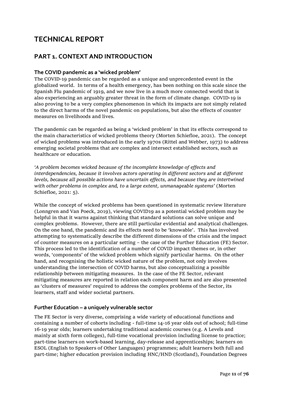
Page 11 of 76
TECHNICAL REPORT
PART 1. CONTEXT AND INTRODUCTION
The COVID pandemic as a 'wicked problem'
The COVID-19 pandemic can be regarded as a unique and unprecedented event in the
globalized world. In terms of a health emergency, has been nothing on this scale since the
Spanish Flu pandemic of 1919, and we now live in a much more connected world that is
also experiencing an arguably greater threat in the form of climate change. COVID-19 is
also proving to be a very complex phenomenon in which its impacts are not simply related
to the direct harms of the novel pandemic on populations, but also the effects of counter
measures on livelihoods and lives.
The pandemic can be regarded as being a 'wicked problem' in that its effects correspond to
the main characteristics of wicked problems theory (Morten Schiefloe, 2021). The concept
of wicked problems was introduced in the early 1970s (Rittel and Webber, 1973) to address
emerging societal problems that are complex and intersect established sectors, such as
healthcare or education.
'A problem becomes wicked because of the incomplete knowledge of effects and
interdependencies, because it involves actors operating in different sectors and at different
levels, because all possible actions have uncertain effects, and because they are intertwined
with other problems in complex and, to a large extent, unmanageable systems' (Morten
Schiefloe, 2021: 5).
While the concept of wicked problems has been questioned in systematic review literature
(Lonngren and Van Poeck, 2019), viewing COVID19 as a potential wicked problem may be
helpful in that it warns against thinking that standard solutions can solve unique and
complex problems. However, there are still particular evidential and analytical challenges.
On the one hand, the pandemic and its effects need to be 'knowable'. This has involved
attempting to systematically describe the different dimensions of the crisis and the impact
of counter measures on a particular setting - the case of the Further Education (FE) Sector.
This process led to the identification of a number of COVID impact themes or, in other
words, 'components' of the wicked problem which signify particular harms. On the other
hand, and recognising the holistic wicked nature of the problem, not only involves
understanding the intersection of COVID harms, but also conceptualizing a possible
relationship between mitigating measures. In the case of the FE Sector, relevant
mitigating measures are reported in relation each component harm and are also presented
as 'clusters of measures' required to address the complex problems of the Sector, its
learners, staff and wider societal partners.
Further Education - a uniquely vulnerable sector
The FE Sector is very diverse, comprising a wide variety of educational functions and
containing a number of cohorts including - full-time 14-16 year olds out of school; full-time
16-19 year olds; learners undertaking traditional academic courses (e.g. A Levels and
mainly at sixth form colleges), full-time vocational provision including license to practice;
part-time learners on work-based learning, day-release and apprenticeships; learners on
ESOL (English to Speakers of Other Languages) programmes; adult learners both full and
part-time; higher education provision including HNC/HND (Scotland), Foundation Degrees